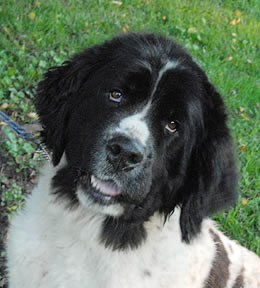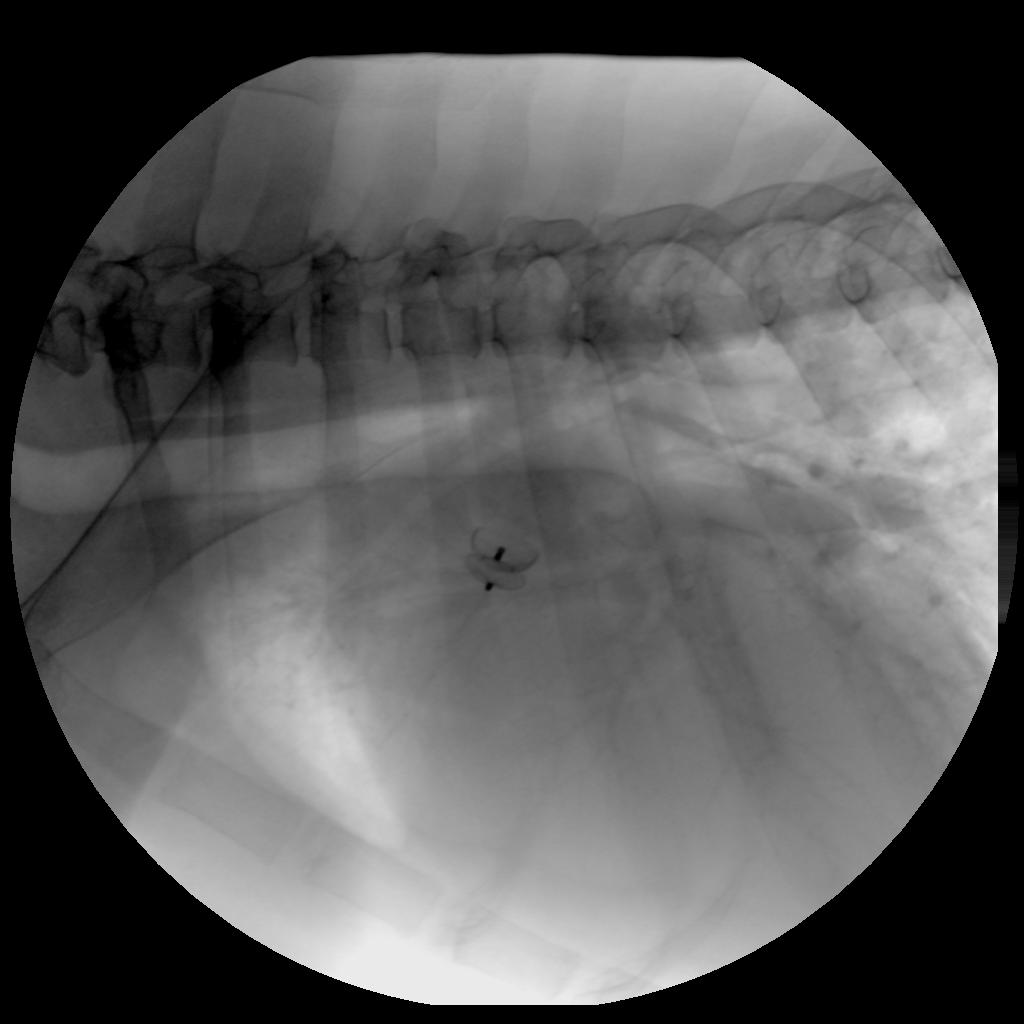by Susan Kerby, Co-Chair, South Central Newfoundland Rescue in collaboration with Dr. Brian Skansen, DVM, MS, Dipl ACVIM (Cardiology) at The Ohio State University College of Veterinary Medicine
reprinted from NewfTide 4th Quarter 2010 pp 28-29
 There are a lot of Newfoundlands that touch our hearts. Mollie, not only touches our heart, but also shows us how a determined little girl can survive against the odds and do it with a happy attitude. This roughly four-to-five-year-old girl turned a routine rescue upside down by happily evading possible death and spreading her joy for living far beyond life’s challenges.
There are a lot of Newfoundlands that touch our hearts. Mollie, not only touches our heart, but also shows us how a determined little girl can survive against the odds and do it with a happy attitude. This roughly four-to-five-year-old girl turned a routine rescue upside down by happily evading possible death and spreading her joy for living far beyond life’s challenges.
Mollie came into Newfoundland Rescue from a shelter in Northern Indiana. She, and another female, possibly her daughter, had been dropped off by their owner. It was evident that both girls were used repeatedly for breeding, and both were debarked. They acted like puppies after being shaved to remove the matted coats from their previous lives. After visiting a local veterinarian, each girl was sent to a different foster home to begin their new lives. The younger girl found a loving home relatively quickly after her routine spay, but for Mollie, it was the first of four foster homes—not because of behavior issues, but because foster families had vacations scheduled, and as Mollie’s health issues were uncovered, she was moved closer to The Ohio State University College of Veterinary Medicine.
In Mollie’s first foster home, routine pre-op blood work for her spay showed low platelets. Over the next few weeks, it was investigated with x-rays and an abdominal ultrasound, but ultimately the cause was determined to be from the Prednisone prescribed for her severe ear infection. Moving forward with a new foster family and clear blood work, Mollie was back on schedule to be spayed, so a forever home could be found. During her pre-op exam, a strong murmur was found and physically felt by touch on her side. This is called a “thrill,” and Mollie’s was very notable. A “thrill” is a typical description of what can be felt when abnormal blood flow is present in the heart or great vessels. Changing the plans for her spay, an ultrasound was done of her heart. The results were not good.
Mollie’s heart had multiple problems, and all the chambers were dilated. The results indicated Patent Ductus Arteriosus (PDA) and Sub-Aortic Stenosis (SAS) with Mitral Regurgitation (MR), and Tricuspid Regurgitation (TR). Basically, there were high pressures across the aortic valve, and her heart was enlarged from working so hard. The recommendation was that she be seen by a cardiac surgeon. Given the severity of her diagnosis, it was important for Rescue to get as much information as possible, so it could be determined if Mollie needed to be placed in a home as she was or if she needed something more. Rescue needed to be able to answer questions so her future family would be aware and informed of Mollie’s health issues. For Mollie’s part, she only knew that it was a feeling she had always lived with, and she was happy to be living inside in the air conditioning, with her tail going full speed ahead.
A consultation appointment was made with Dr. Brian Scansen, DVM, MS, Dipl ACVIM (Cardiology) at The Ohio State University Veterinary Medical Center. Dr. Scansen and his senior student, Kristen, examined Mollie and read the reports from the previous consultations. He agreed with the initial report that Mollie had a high probability of having SAS and PDA, but felt that the PDA was causing the high pressures, and it was affecting the overall heart condition. He felt that he needed more information to decide if anything could/should be done to help her quality of life or to determine how much damage had already been done to her heart. He requested that we allow him to do another ultrasound along with an x-ray so he could better assess her
|
|
Ultrasound of Mollie’s heart (an echocardiogram) shows high velocity turbulent (green) blood flow from the aorta to the pulmonary artery consistent with a PDA. Angiography (real-time X-rays) shows the location of the PDA and directs a device (ACDO) to the PDA to rapidly close the defect. |
He initially discussed the possibility of closing the PDA (a blood vessel that should have closed at birth) to help reduce the pressures across the aortic valve and in turn help with what he concurred was probably SAS. (SAS is a ridge/ring forming in the aortic valve area, slowly tightening down flow as it progresses.) By closing the PDA, there would be reduced blood flow, leading to less pressure in the heart chambers. Dr. Scansen felt that this would indeed help Mollie feel better overall, as her heart would not have to work as hard to accommodate all the blood flow, and in turn her breathing should become easier.
South Central Newfoundland Rescue agreed with his recommendation and Mary L. Price (NCA Rescue) was called for guidance. This not only helped assure that SCNRescue would have extra funds available if needed, but Mary helped clarify how to make the choice if the surgery would be desirable for Mollie’s future. Rescue needed to know if the surgery would help Mollie by giving her a better quality of life. Fortunately, Dr. Scansen had already helped with this answer as the surgery would decrease the pressures overall in her heart, lessening the pressures/strain of what was thought to be SAS.
After the ultrasound, Dr. Scansen informed us that he suspected that Mollie did not have SAS, as he did not see any ridge that is common with SAS. He said it could still be there but it could be extremely slight, making it mild SAS (no ridge seen) if any at all. By closing the PDA, it would definitely improve the pressures within her heart and lungs. He noted some mild damage to the left side of the heart but that was not the big problem of high concern at this point. The left side of the heart would also benefit by closing the PDA. Overall, his recommendation was to close the PDA, and Mollie would have an increase in her life expectancy as her current condition was becoming severe and she would not have long without closing the PDA— possibly weeks or months. It is never an exact science to know for sure, but her heart was working overtime. Mollie was already on borrowed time as untreated PDA is fatal in 60 percent of dogs within a year of diagnosis.
SCN Rescue, recognizing the criteria Mary Price mentioned, decided to go forward with the surgery. Mollie stayed at OSU in Dr. Scansen’s care, scheduled for surgery two days later. The surgery went excellently. A tiny expanding wire mesh, “Canine Duct Occluder,”1 conformed to the shape of the PDA was inserted through the femoral artery in her back right leg. A few hours after surgery, Mollie recovered very well, thumping her tail as her vet student Kristen talked to her. Another ultrasound was done the next morning before SCN Rescue picked her up, and it was determined that the PDA was indeed closed, and the pressures across the aortic valve were already down to the high normal range with no visible SAS found. It is expected that her heart will gradually go down in size with the reduction in blood flow from the PDA closure. She was started on a low dose of Enalapril to help keep the fluid away from her heart.
Dr. Scansen did the follow-up ultrasound two months later, and her prognosis remains good but “guarded.” She is no worse, and the PDA repair has definitely helped her overall, but the damage to her left side of her heart from pumping so much blood for so long, has taken its toll on her heart muscle. She has improved health, and is definitely more comfortable. We know she will never physically have a perfect heart, but her happiness is contagious, and she has no problem running at her own pace around the backyard. She had an increase in activity level and alertness within days of her surgery and that continues today. Before her surgery, she had no interest in trotting, but within a few days after her surgery, she loved trotting to the end of her flexi lead and trotting back to check in. We know that Dr. Scansen and Newfoundland Rescue have helped her live better for whatever time she has left.
Mollie was finally spayed at OSU with Dr. Scansen nearby to monitor her recovery. Everything went well, and a normal spay recovery is now in progress. She has been started on a beta blocker to help protect the heart muscle. (Beta blockers block the adrenaline receptors that make and delivering multiple litters of puppies, and living with a heart condition that damaged her heart with every beat. Now she has a loving family of her own. She looks up, rather than putting her head down to bulldoze through the house. Her biggest problem is deciding which fluffy dog bed to sleep on. No more puppies; no more being physically manhandled; no more needing to hit the deck when someone reaches down to pet her. Mollie is happy and has the temperament of the Newfoundland in spades. She’s an awesome girl, who has taken all the changes and moves in stride, meeting new friends along the way and inspiring everyone to realize that even with the worst health issues, you can still be happy and live. Some people may question why we did all of this for Mollie, and our reply is—she is a Newfoundland and her favorite toy is a simple ball!
References:
1) The device used in the surgery is AMPLATZ® Canine PDA Device (http://infinitimedical.com/p_occlusion_ devices.html)
2) Video and x-ray courtesy of Dr. Brian Scansen DVM, MS, Dipl ACVIM (Cardiology)

